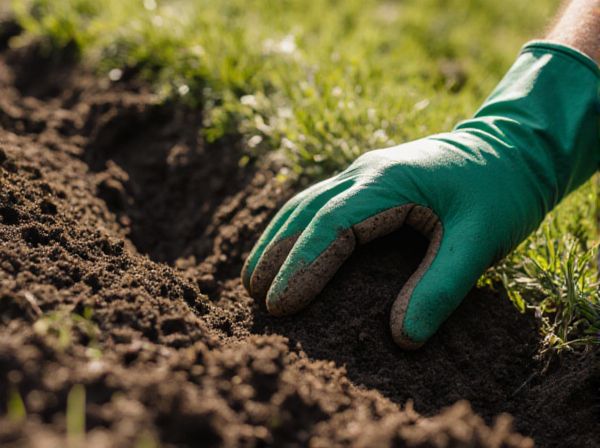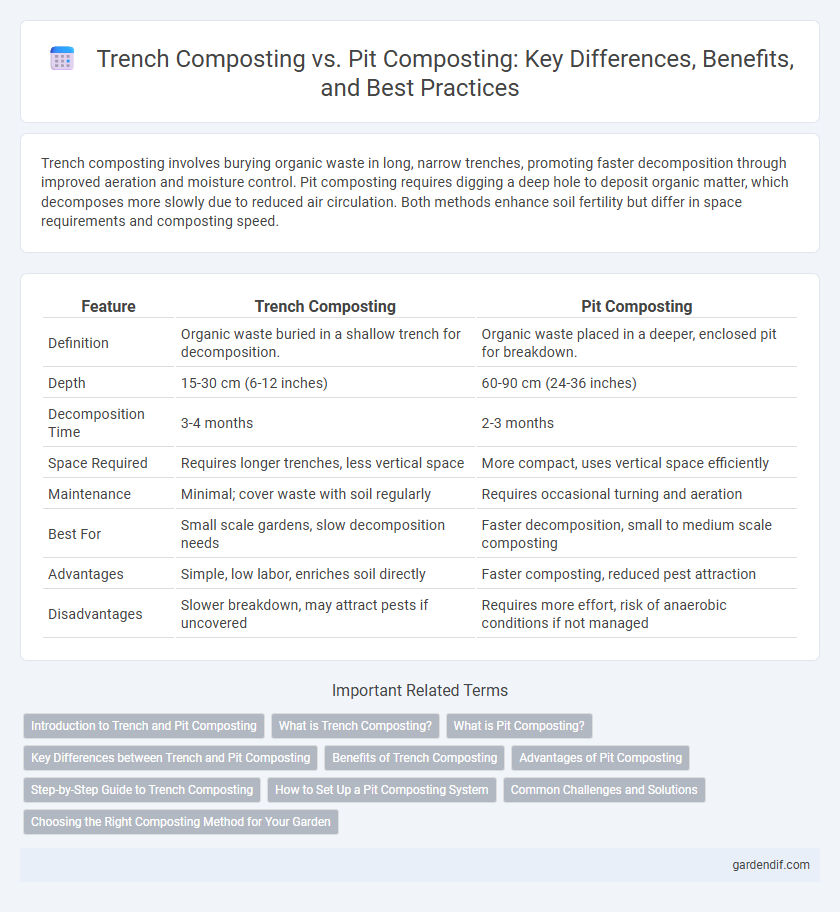
Trench Composting vs Pit Composting Illustration
Trench composting involves burying organic waste in long, narrow trenches, promoting faster decomposition through improved aeration and moisture control. Pit composting requires digging a deep hole to deposit organic matter, which decomposes more slowly due to reduced air circulation. Both methods enhance soil fertility but differ in space requirements and composting speed.
Table of Comparison
| Feature | Trench Composting | Pit Composting |
|---|---|---|
| Definition | Organic waste buried in a shallow trench for decomposition. | Organic waste placed in a deeper, enclosed pit for breakdown. |
| Depth | 15-30 cm (6-12 inches) | 60-90 cm (24-36 inches) |
| Decomposition Time | 3-4 months | 2-3 months |
| Space Required | Requires longer trenches, less vertical space | More compact, uses vertical space efficiently |
| Maintenance | Minimal; cover waste with soil regularly | Requires occasional turning and aeration |
| Best For | Small scale gardens, slow decomposition needs | Faster decomposition, small to medium scale composting |
| Advantages | Simple, low labor, enriches soil directly | Faster composting, reduced pest attraction |
| Disadvantages | Slower breakdown, may attract pests if uncovered | Requires more effort, risk of anaerobic conditions if not managed |
Introduction to Trench and Pit Composting
Trench composting involves burying organic waste in long, narrow trenches where it decomposes underground, promoting efficient microbial activity and moisture retention. Pit composting uses a larger, deeper hole allowing for substantial organic matter accumulation and slower decomposition due to limited aeration. Both methods reduce surface exposure, minimizing odor and pest issues while enriching soil directly at the compost site.
What is Trench Composting?
Trench composting involves burying organic waste in long, narrow trenches typically 12-18 inches deep, allowing natural decomposition beneath the soil surface. This method accelerates nutrient recycling by creating ideal conditions for microbial activity and moisture retention, promoting soil enrichment directly where plants grow. Its low-maintenance design makes trench composting an efficient solution for gardeners aiming to improve soil fertility and structure sustainably.
What is Pit Composting?
Pit composting is an organic waste management method where biodegradable materials are deposited into a dug hole or pit, allowing natural microbial processes to decompose the matter in a confined space. This technique enhances nutrient retention and moisture conservation, accelerating the breakdown of compostable materials directly into the soil. Pit composting is particularly effective for small-scale gardening due to its simplicity, low cost, and minimal space requirement.
Key Differences between Trench and Pit Composting
Trench composting involves digging a long, narrow trench where organic waste is buried and covered with soil, promoting faster decomposition through increased aeration and easier integration into garden beds. Pit composting requires digging a deep, compact hole to deposit organic material, facilitating slower decomposition due to limited aeration but allowing for larger volumes in confined areas. The key differences lie in trench composting's suitability for seasonal gardens with quicker nutrient recycling versus pit composting's use for bulk waste in smaller spaces with extended breakdown time.
Benefits of Trench Composting
Trench composting enhances soil fertility by allowing organic waste to decompose directly in the ground, enriching nutrient content and improving moisture retention. This method reduces surface waste accumulation, minimizing pests and odors while promoting faster microbial activity due to better aeration. Trench composting also requires minimal maintenance and space, making it efficient for small gardens and sustainable waste management.
Advantages of Pit Composting
Pit composting offers superior moisture retention and temperature regulation compared to trench composting, promoting faster organic matter decomposition. The compact design minimizes nutrient leaching and reduces the risk of pest intrusion, enhancing compost quality. Its suitability for small garden spaces and ease of maintenance make pit composting an efficient and practical method for sustainable waste management.
Step-by-Step Guide to Trench Composting
Trench composting involves digging a narrow trench 12-18 inches deep and placing organic waste such as kitchen scraps and garden clippings directly into the trench, then covering it with soil to promote natural decomposition. Maintaining a consistent layer of moist, nitrogen-rich materials accelerates the breakdown process, resulting in nutrient-rich compost that feeds plants directly in the soil. This method minimizes odors and pests while improving soil structure and moisture retention in vegetable beds or garden areas.
How to Set Up a Pit Composting System
Setting up a pit composting system involves digging a hole 2-3 feet deep and wide enough to accommodate daily organic waste deposits such as kitchen scraps, garden clippings, and biodegradable materials. Layering green (nitrogen-rich) and brown (carbon-rich) materials enhances decomposition, while ensuring adequate moisture and occasional aeration promotes microbial activity. Covering the pit with soil or a wooden lid helps retain heat and moisture, speeding up the natural composting process.
Common Challenges and Solutions
Trench composting and pit composting both face common challenges such as poor aeration, slow decomposition, and pest infestations resulting from inadequate coverage or moisture control. Solutions include ensuring proper turning or layering to enhance airflow, maintaining optimal moisture levels by covering the compost with soil or mulch, and using protective barriers to prevent rodents and insects. Effective management of these factors accelerates decomposition and minimizes environmental disturbances in both composting methods.
Choosing the Right Composting Method for Your Garden
Trench composting is ideal for gardeners seeking a low-maintenance method that enriches soil directly by burying organic waste in narrow, deep trenches, promoting faster decomposition and reducing pests. Pit composting suits those with larger garden spaces and bulkier organic waste, allowing for a more controlled environment that retains moisture and heat, accelerating breakdown. Selecting between trench and pit composting depends on garden size, available labor, and desired composting speed, ensuring optimal nutrient recycling and soil health tailored to specific garden needs.
Trench Composting vs Pit Composting Infographic

 gardendif.com
gardendif.com